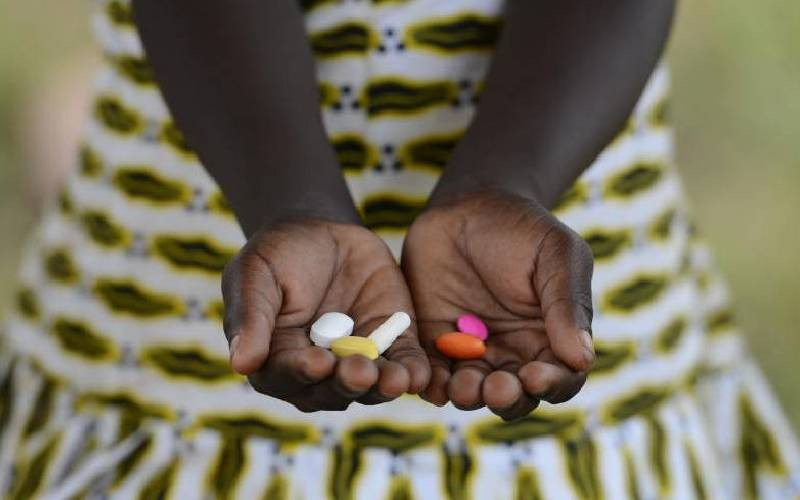
Christopher Kibiwott treats Edward Ndirangu’s wound at his home in Mlolongo. [Beverlyne Musili, Standard]
An old remedy used during the First World War has made a come-back to treat stubborn, slow-healing wounds.
Medicinal maggots are now acceptable in Kenya as a simple, affordable and effective method to promote healing of problematic wounds. Known as Maggot Debridement Therapy (MDT), live disinfected maggots are placed on the wound with a dressing for up to 48 hours to enable them eat away the dead tissue hence encourage growth of new skin.
The maggots clean the wound with an enzyme, disinfect the wound, using their mouth hooks to stimulate and rough up the wound bed, which encourages the healing process. Edward Ndirangu, 47, is one patient who has welcomed these ‘micro-surgeons’ to deal with a three-month wound that stubbornly sits on the sole of his right foot. Eddie, as his wife Lucy fondly refers to him, has been diabetic for 13 years, managing the lifestyle condition through daily insulin injections, adhering to diet restrictions and exercising.
However, while on a business trip to Mombasa in December last year, he developed blisters on both feet. Those on the right became bigger wounds and did not respond to a regimen of antibiotics.
Exerted pressure
“I took a long walk that exerted pressure on my feet, leading to small blisters that became painful and bigger with each passing day,” says Eddie in an interview at his home. The businessman is now immobilised by the wound and together with his wife, who works as a nurse at the Kenyatta National Hospital (KNH), is exploring prospects of maggot therapy at their home.
On the application day, Bernard Wanyonyi, who works as a lab technician at the Kenya Agricultural and Livestock Research Organisation where the maggots are bred in controlled conditions, carries a cooler box containing the worms.
“We use the green blow fly, scientifically known as Lucilia sericata, because it has a long standing history in medicine in the treatment of wounds,” says Bernard. According to him, the green blow flies lay eggs under controlled conditions in the laboratory when they are 24 hours old.
For today’s assignment, Bernard has carried 2,000 maggot hatchlings, each a millimetre or two long in two containers with air holes stored in a cool box. Before the maggots are administered, the size of the wound is measured to determine the appropriate number of maggots required for efficient debridement.
“For one cubic centimetre of the wound, we need eight maggots. The maggots should neither be too many to compete for the dead tissue that serves as their food, nor too few that they cannot adequately cover the wound,” says Bernard.
The wound is prepared by Christopher Kibiwott, a nurse; he moistens the wound with saline solution so the maggots can have a surface they can attach themselves to. Eddie has no objection even after Christopher explains that after 24 hours he may feel the worms crawling as they navigate the wound.
“As long as they are doing their work, I will be very comfortable with them on my skin. That is the only way I will recover,” Eddie says.
Two bottles containing 1,000 maggots each are handed over to Christopher who uses a sterile gauze to apply them on the wound. They attach like glue to Eddie’s wound. They are barely visible but their movement is evident on the walls of the bottle they are contained in. A net-like covering is placed on the wound to restrain them from wandering off beyond the wound.
An external dressing is loosely placed on the wound so that air enters the wound and also to ensure the maggots do not suffocate. “The maggots may attempt to escape from the wound, that is why we have placed the dressing to confine them to their areas of action,” says Christopher.
By the second day, the dressing has become wet due to liquefied dead tissue, evident that the micro surgeons are working. According to Christopher, MDT has at times been considered to outsmart the surgeons’ sharp scalpel.
“This is a rapid, effective, safe and economical treatment method that has been underutilised in Kenya and the rest of Africa,” says Christopher, who has used medicinal maggots on his patients for the last five years.
He is part of the team that uses MDT at KNH on patients who provide consent. After the much awaited 48 hours, Christopher is ready to remove the maggots. The black spots that were dead skin two days ago have been eaten off by the maggots.
It is time to open the wound. The previous one millimetre maggots crawl, forming a micro-colony. They have grown to about 10 to 14 millimetres. Eddy beams at the sight of his ‘freshly cleaned’ wound. “The black skin is gone. It looks good. Wow, I am impressed,” says Eddie in disjointed speech, awed by the clean and seamless work done by the maggots.
His wife Lucy takes a closer look at the wound. “I am very impressed. I am glad we opted for maggot therapy,” she says as Christopher cleans the wound. A clean dressing is placed for another seven days to encourage the wound’s self-healing. At this point, the maggots are destroyed immediately to prevent them from maturing into flies.
“Their work is over,” Kibiwott says of the maggots he places them in a polythene bag to suffocate them. The cost of the maggot therapy is Sh4,000 - affordable to most patients because it is applied within their homes.
Plastic and Reconstructive Surgeon Joseph Wanjeri hails the medical use of disinfected fly larvae in treatment of wounds that are resistant to conventional treatment.
“The maggots were successfully used during the First and Second World wars on injured soldiers. But the treatment fell out of favour with discovery of antibiotics that became the miracle wonders of the medical world. However, we are back where we began because antibiotics resistance is a major public health problem,” says Dr Wanjeri.
Supported by research
Dr Wanjeri adds: “The use of maggots is now supported by medical research because it has been shown to promote regeneration of new tissue, which is part of recovery.”
The lecturer at the University of Nairobi’s Department of Surgery at the School of Medicine says acceptance and utilisation of this biological method should be considered especially in developing countries like Kenya, where access to skilled surgeons is limited.
With confidence, he adds that maggot therapy can perform the same task that a surgeon’s scalpel can. Currently, maggot therapy is being used at KNH to treat various types of wounds.
After the wound is wrapped and the maggots destroyed, Eddie jokingly recalls the creepy sensation he experienced when he was undergoing treatment. He is grateful because he is on his way to recovery.
“I will share the news on the miracles of my crawly creepy friends,” concludes the happy patient who can also be termed a Maggot Debridement Therapy advocate.
-The writer is Health Medicine Editor at The Conversation Africa (theconversation.com/africa)
 The Standard Group Plc is a multi-media organization with investments in media
platforms spanning newspaper print
operations, television, radio broadcasting, digital and online services. The
Standard Group is recognized as a
leading multi-media house in Kenya with a key influence in matters of national
and international interest.
The Standard Group Plc is a multi-media organization with investments in media
platforms spanning newspaper print
operations, television, radio broadcasting, digital and online services. The
Standard Group is recognized as a
leading multi-media house in Kenya with a key influence in matters of national
and international interest.











